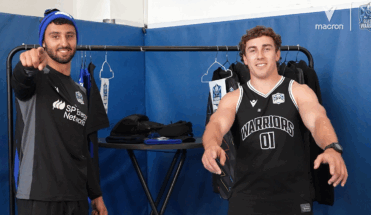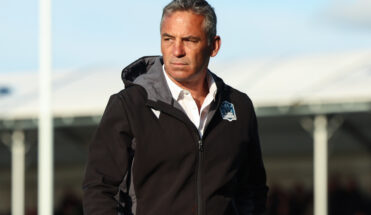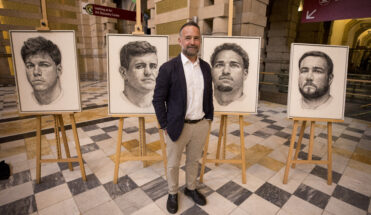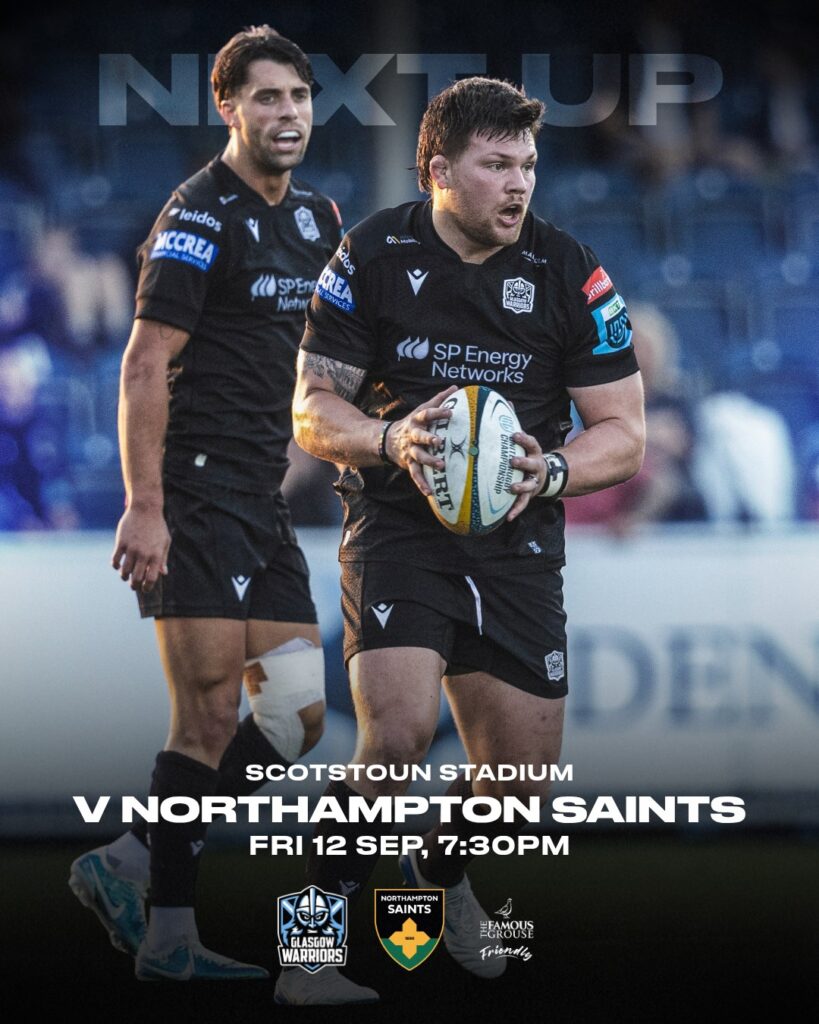Nomads to legends | The story of Glasgow Caledonians
It's a colour combination that immediately sends the Warrior Nation reminiscing into rapture.
To this day, the red and blue of Glasgow Caledonians – formed by a merger between Glasgow and the Caledonian Reds in 1998 – retain a special place in the hearts of many supporters, their popularity enduring almost 20 years after the merger came to an end.
It’s a period that still holds great sway in the memories of those involved at the time, too, as the then-club captain explains.
“I’m hugely proud to have been a part of the club’s history, said Andy Nicol.
“Dave Jordan was the boss at Glasgow at the time, and we met and discussed that this merger was going to be happening. It sounded great – what Dave didn’t tell me though was that every second week we’d be on an eight-hour bus journey down to Wales every other week in the new Scottish-Welsh league! It’s definitely not the ideal way to prepare for a match, stopping off at a service station to stretch off – it wasn’t quite the slick professional outfit you see these days!
It wasn’t just the new league system that took some getting used to for the Caledonians; with rugby having turned professional just two and a half years before the merger, there was still a significant element of adapting to the new sporting landscape that surrounded the club in its infancy.
“It was an era of mass change, to be honest,” said Gordon Bulloch.
“At that time we were leading a pretty nomadic existence – we didn’t have a permanent home, we didn’t have a permanent training base, and we were pulling together players who weren’t necessarily representing their region.”
Nomadic would be putting it mildly, as Nicol explains.
“Because we were playing as Glasgow Caledonians, most of our matches were at Hughenden but we took games to Perth and Aberdeen amongst other places.
“We trained in Motherwell at Dalziel, we did our weights sessions at Grangemouth, half the squad lived in Edinburgh and half the coaches lived in the Borders.
“We didn’t have a permanent base until much later on, and there was a lot of moving around. We got off to a slow start in professional rugby, I’d say – it was very much learning on the hoof.”

Yet the Glasgow Caledonian travelling circus had their eyes set on entertaining the masses, as they embarked on their odyssey across the newly-formed Scottish-Welsh league. Even the mere discussion of the talent boasted by the squad brings a smile to both Bulloch and Nicol as they recall their fellow Reds.
“It was a squad packed with characters and talent” grinned Bulloch.
“Glenn [Metcalfe] had come across to play for Glasgow Accies, and then suddenly found himself representing the district and what would become Glasgow Warriors. You had guys like Gordy McIlwham, Jason White and Donnie Macfadyen involved – all quality players.
“[Bulloch’s brother] Alan was a very good player, too. He was able to break tackles with ease and he had good skills with ball in hand. To have played together for Glasgow is a proud achievement for both of us.”
If the team was the travelling circus, then one man stood tall as the ringmaster. The incomparable Tommy Hayes to this day remains one of Glasgow’s most famous adopted sons, the Cook Islands international having delighted the Warrior Nation with his box of tricks during a spell that saw him become the fastest player to 100 club appearances and the first player to score 1,000 points for the club – amongst a host of other records.
As his frequent partner in the half-backs, Nicol had a front-row seat to the show.
“Tommy was probably the best and worst fly-half I’ve ever played with – probably in the same game, and possibly even the same move!” laughed the former scrum-half.
“I mean that with great affection, because Tommy had every skill and talent required to be one of the world’s best fly-halves. His only weakness was that he could switch off at times – consistency was the only thing that stopped him being an absolute worldie.
“He had pace, he had strength, his passing and kicking were both off the scale and he could see things others couldn’t. He was outstanding.”

It wasn’t just on the field that the team were prepared to compete, though. As the team’s captain revealed, the bus journeys home from the long treks to Wales could be just as nail-biting as some of the club’s most tense encounters.
“The card school on the bus back was always popular,” laughed Nicol.
“Gordon [Bulloch], Jim McLaren and Jonny Petrie were the big competitors, and Dave Jordan joined in too – shouting and swearing at your boss after he throws down an ace when you don’t want him to is a novel experience!
“Arriving home at 2am with coins in my pocket meant my wife knew I’d had a good journey. If it was silent, it meant one of two things; I’d either had a really bad night, or I’d come home with notes in my pocket after a very good night!”
For Bulloch, the team provided a chance to throwback to the amateur era in another way.
“I used to drop kick conversions if we were losing and chasing the game,” smiled the former Scotland hooker.
“I think I got one against Stade Francais in the European Cup, and I got another one somewhere. I had a 100% record though, make sure to put that down!”
Whilst the Glasgow Caledonians brand bowed out at the end of the 2000/01 campaign, it did so on a high note as it celebrated producing it’s first two British and Irish Lions. Both Bulloch and Nicol were part of the 2001 British and Irish Lions tour to Australia, with Bulloch coming off the bench to earn the first of two caps in the Lions’ first Test victory at the Gabba.
“To represent the Lions was fabulous,” said the hooker.
“It was an outstanding opportunity to go and mix with players you’d only ever get the chance to play against if it wasn’t for the Lions – guys like Keith Wood, Martin Johnson and Rob Howley. It was the absolute pinnacle of my career.”
Nicol’s 2001 Lions tale? It’s safe to say it’s slightly different to his former Glasgow and Scotland team-mate’s.
“I’d captained Scotland in the 2001 Six Nations, and I thought I had a chance of going on the tour but ended up not being selected,” he explained.
“I’d just turned 30 so I knew I was getting close to the end of my career, so when I was given the chance to lead a supporters’ tour I said yes. It was a hell of a party – I think I’d been drinking for 20 days, and then I got the call from Donal Lenihan [tour manager] and being told I might be required to sit on the bench for the third and deciding Test!
“I was booked in to climb the Sydney Harbour Bridge and at 11pm the night before the Test I was on top of the Bridge – the following day I’m on the bench in a deciding Test match.”
And so ended the Glasgow Caledonians, those famous red jerseys consigned to the history books and its legacy simply the memories held by supporters across Scotland. Right?
Wrong.
The Caledonians were simply the beginning.

“Playing professional rugby in Scotland was never something I’d thought was possible growing up,” explained Bulloch.
“If you wanted to play professionally you had to move down to England and play rugby league. You were suddenly living the dream when the contract came through the post from Scottish Rugby – I was in my second year of university at the time and nothing was going to get a look in after I got that contract!”
Nicol continued: “Back then, the young players coming through had no concept of professional rugby – they had no experience of elite rugby, so it was important for the senior pros like myself to set the right example.
“I remember guys like Barry Irvine and Andy Henderson were absolute sponges, wanting to learn at every opportunity. They wanted to fill their entire day with rugby. It was new territory for these guys.
“Those guys became the next generation of Glasgow Warriors, and then they in turn taught the young players coming through, and so it continued.
“I was lucky enough to be at Allianz Park for the first European quarter-final in 2017, and I’m not ashamed to admit I had a tear in my eye – to be in the crowd as part of 6,000 travelling supporters that day? Unforgettable.”
Related Fanzone


Meet the new backs!


2025/26 Macron leisurewear range on sale


Mic’d Up Murphy

Duncan relishing pre-season graft

“An incredible opportunity to measure ourselves against the best” | Smith


Pride and Portraits

Murchie proud of effort despite Dublin defeat

Jordan ready for final four showdown

Match Preview | Leinster (A) | URC Semi Final



